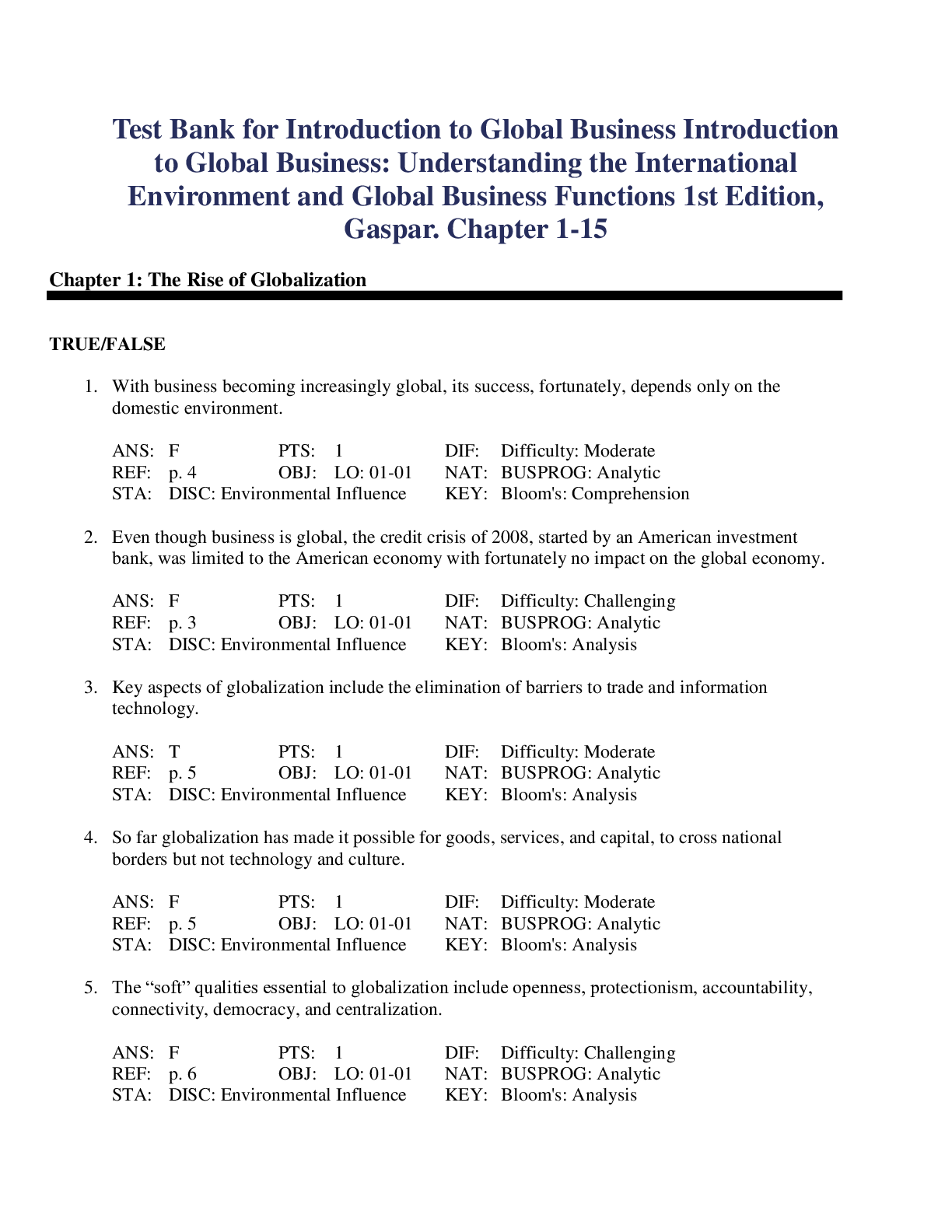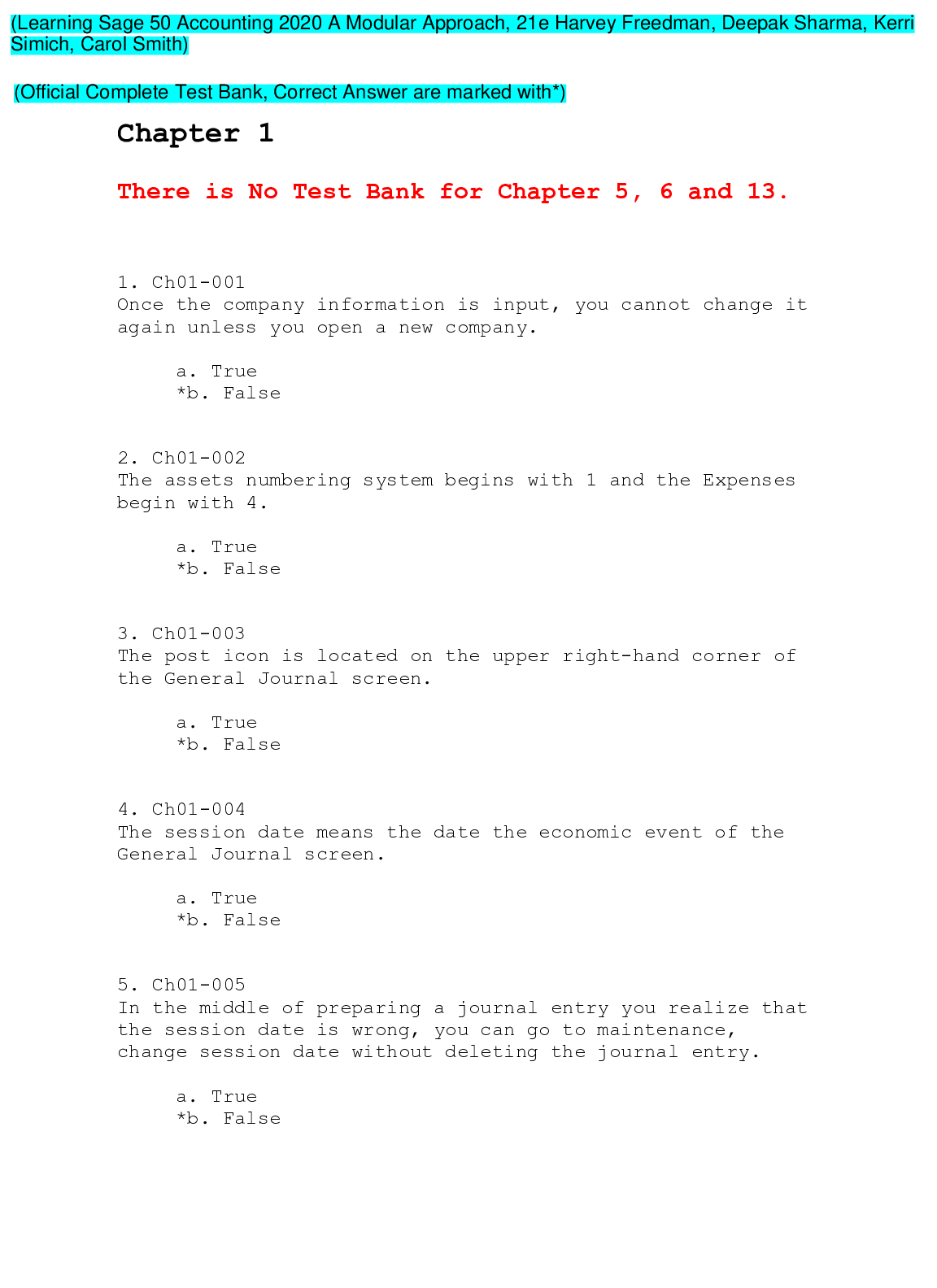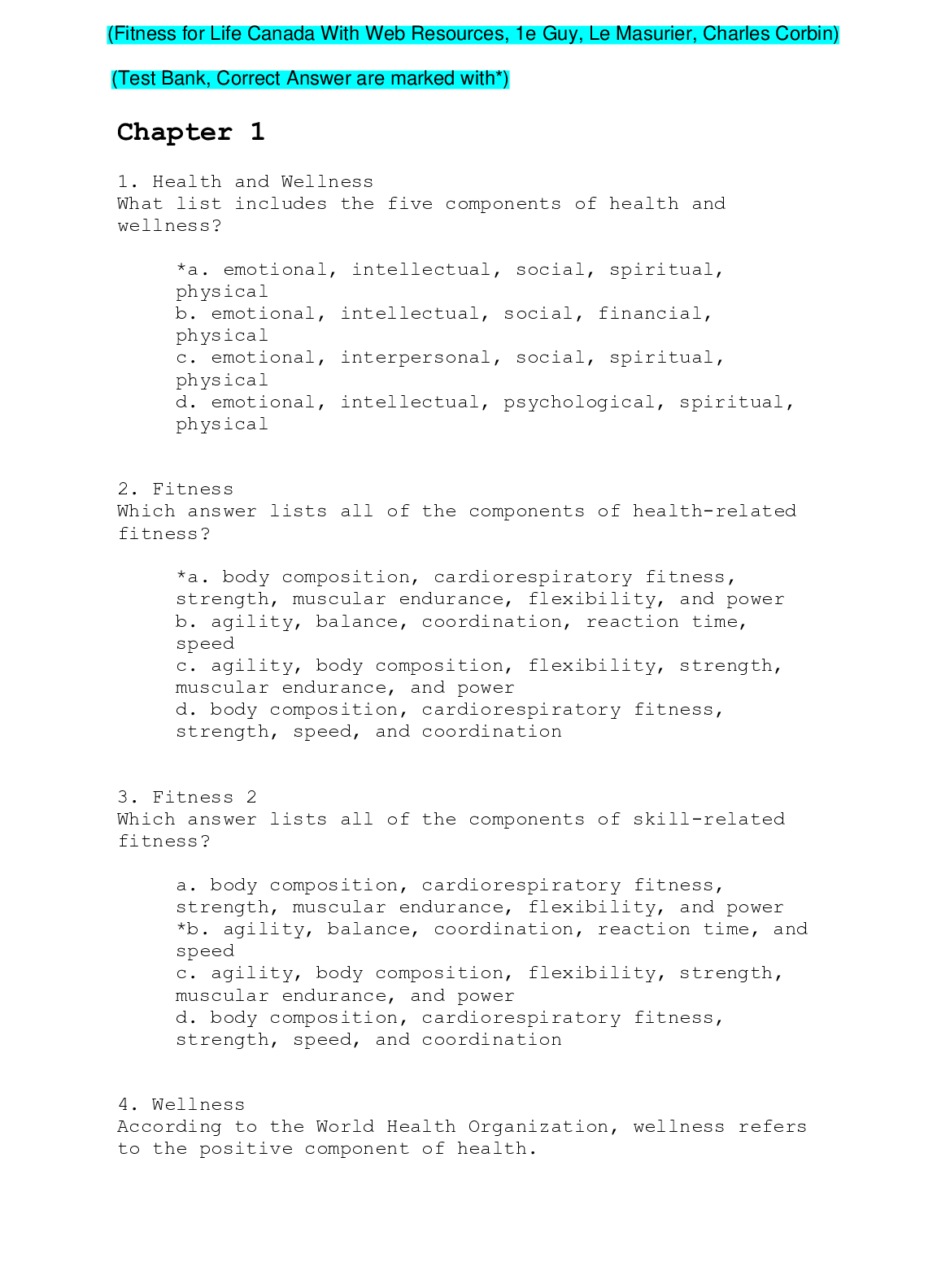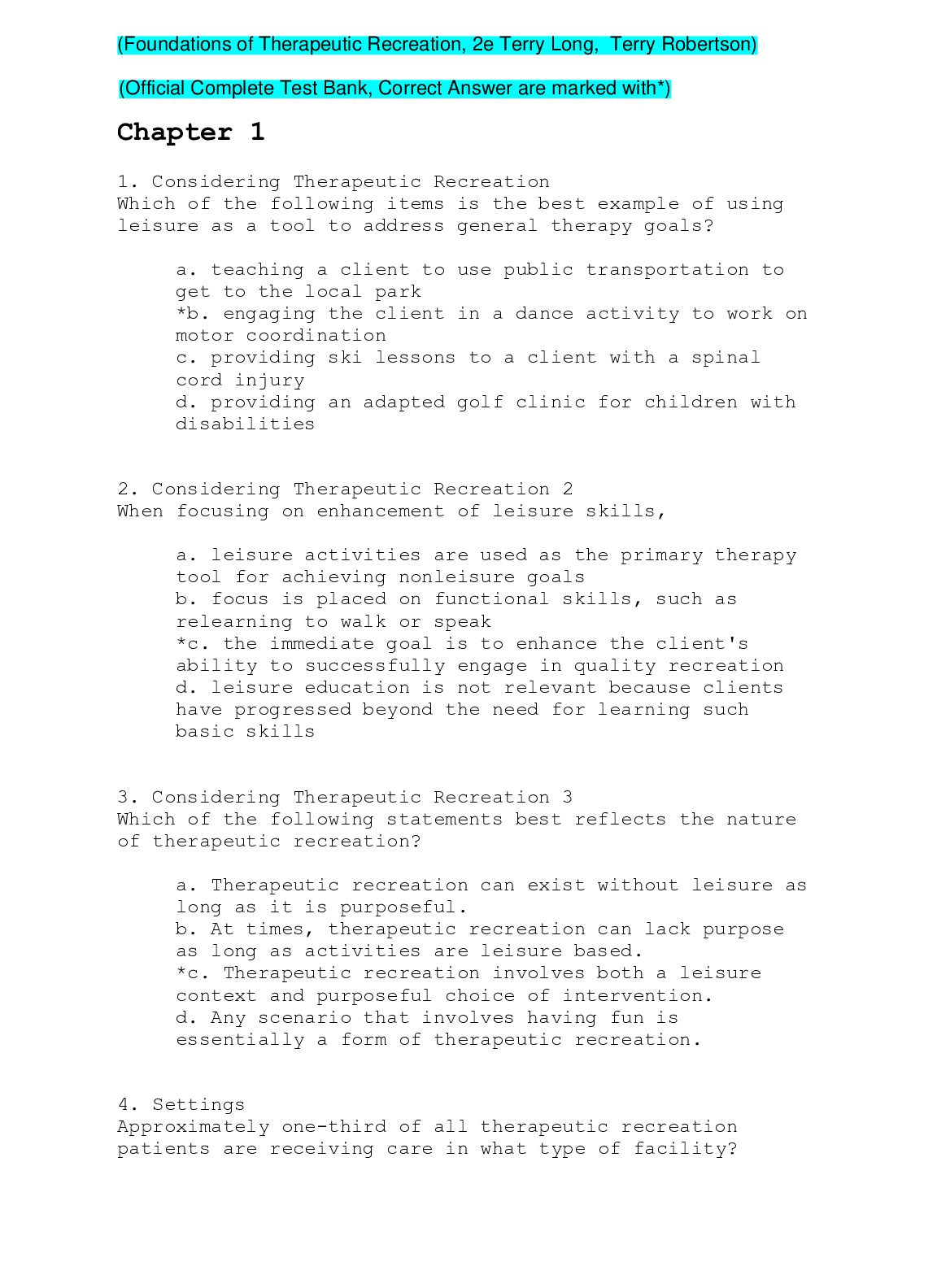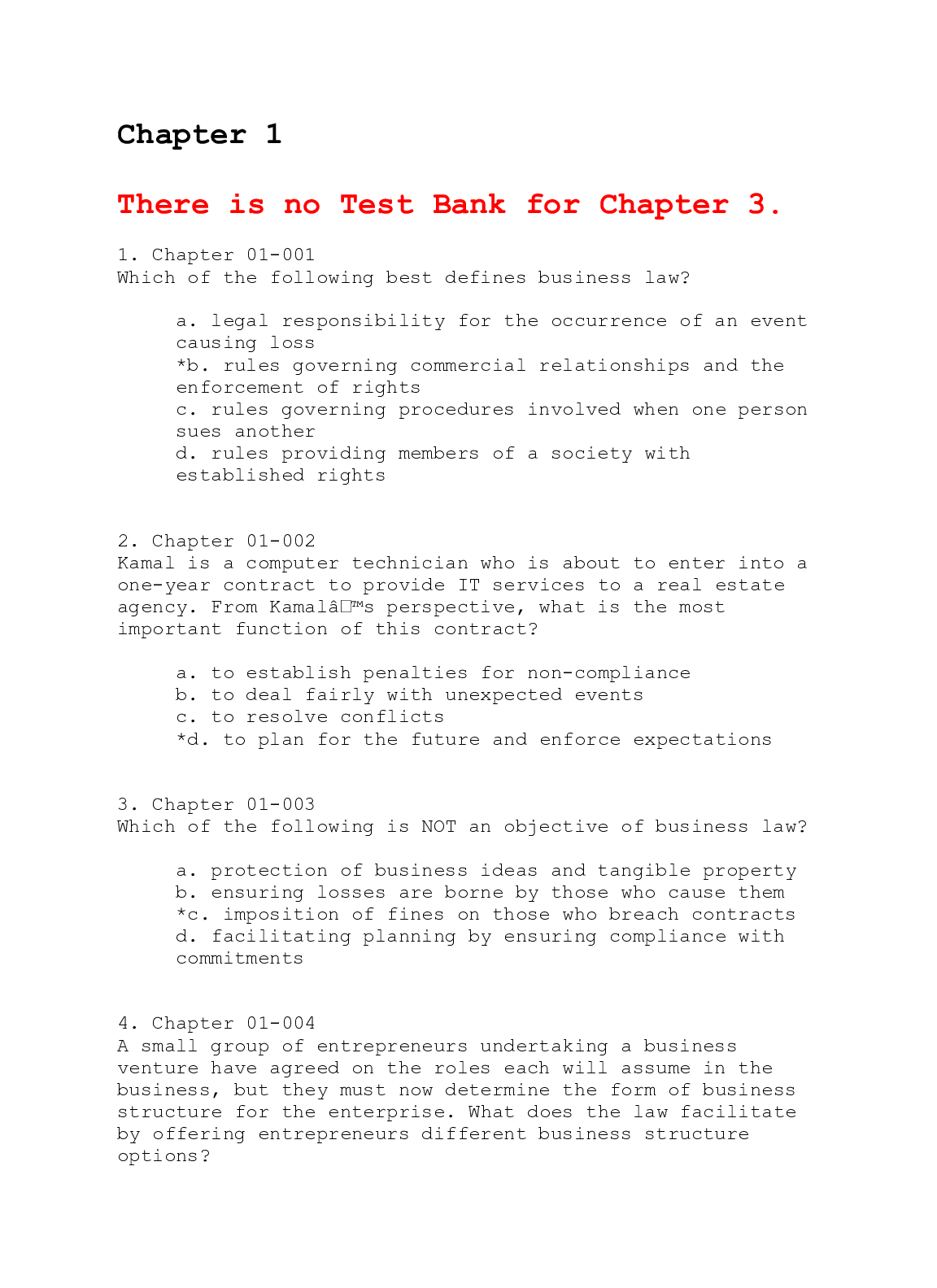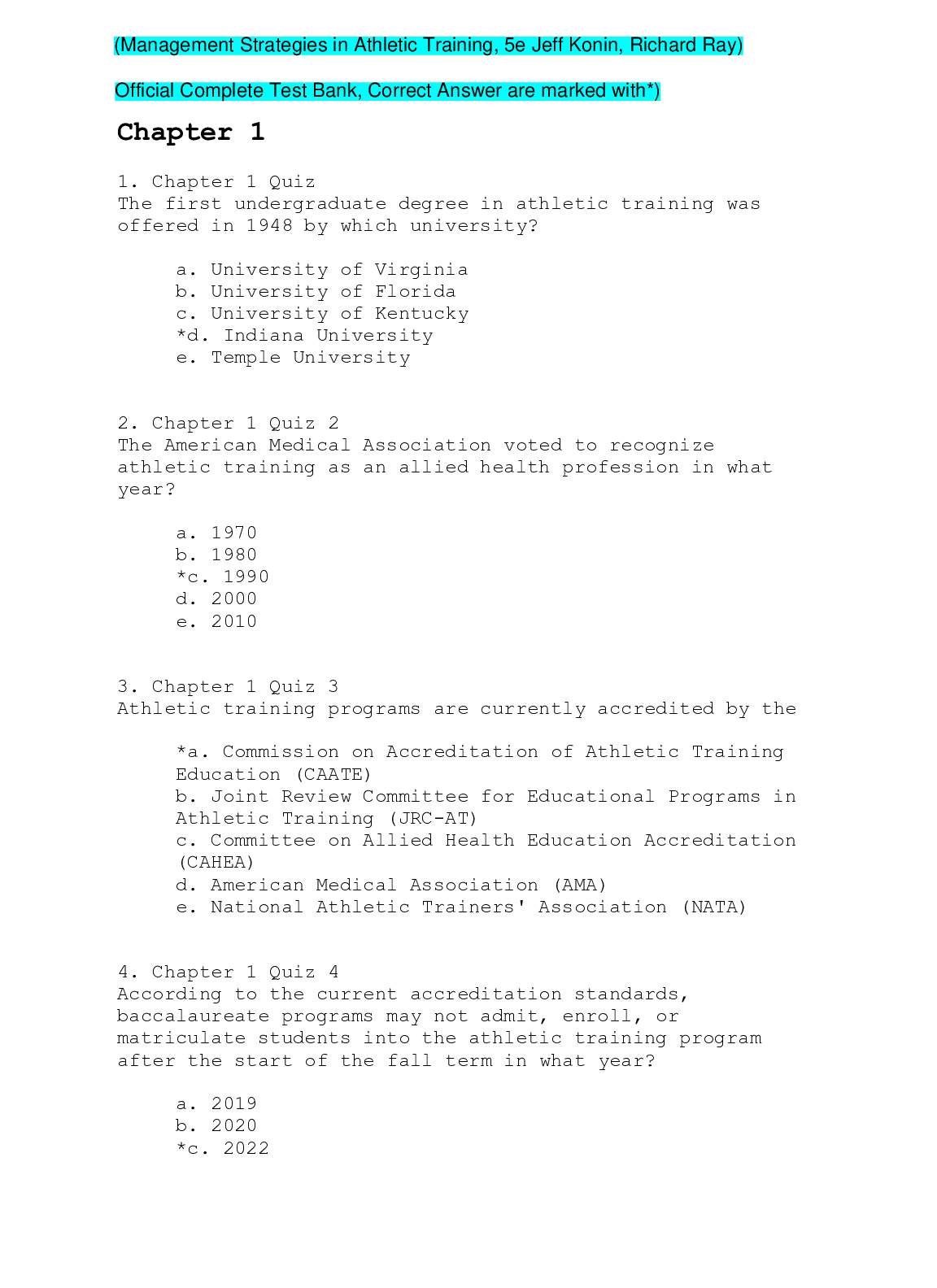TEST BANK NEUROSCIENCE/6TH EDITION By: Dale Purves
Document Content and Description Below
Neuroscience / Edition 6 by Dale Purves Test Bank Table of Contents: Chapter 1. Studying the Nervous System Chapter 2. Electrical Signals of Nerve Cells Chapter 3. Voltage-Dependent Membrane Perme... ability Chapter 4. Ion Channels and Transporters Chapter 5. Synaptic Transmission Chapter 6. Neurotransmitters and Their Receptors Chapter 7. Molecular Signaling within Neurons Chapter 8. Synaptic Plasticity Chapter 9. The Somatosensory System: Touch and Proprioception Chapter 10. Pain Chapter 11. Vision: The Eye Chapter 12. Central Visual Pathways Chapter 13. The Auditory System Chapter 14. The Vestibular System Chapter 15. The Chemical Senses Chapter 16. Lower Motor Neuron Circuits and Motor Control Chapter 17. Upper Motor Neuron Control of the Brainstem and Spinal Cord Chapter 18. Modulation of Movement by the Basal Ganglia Chapter 19. Modulation of Movement by the Cerebellum Chapter 20. Eye Movements and Sensory Motor Integration Chapter 21. The Visceral Motor System Chapter 22. Early Brain Development Chapter 23. Construction of Neural Circuits Chapter 24. Circuit Differentiation: Intrinsic Factors and Sex Differences Chapter 25. Experience-Dependent Plasticity in the Developing Brain Chapter 26. Repair and Regeneration in the Nervous System Chapter 27. Cognitive Functions and the Organization of the Cerebral Cortex Chapter 28. Cortical States Chapter 29. Attention Chapter 30. Memory Chapter 31. Emotion Chapter 32. Thinking, Planning, and Deciding Chapter 33. Speech and Language Chapter 34. Development and Evolution of Cognitive Functions Test Bank to accompany Neuroscience, Sixth Edition Purves • Augustine • Fitzpatrick • Hall • LaMantia • Mooney • Platt • White Chapter 1: Studying the Nervous System Multiple Choice 1. Which part of DNA is transcribed into messenger RNA? a. Exon b. Intron c. Promoter d. Non-coding DNA e. Regulatory DNA Answer: a Textbook Reference: Genetics and Genomics Bloom’s Level: 2. Understanding 2. Genomics is the analysis of a. coding DNA sequences for a species. b. regulatory DNA sequences for an individual organism and a species. c. coding and regulatory DNA sequences for a species. d. coding and regulatory DNA sequences for an individual organism. e. coding and regulatory DNA of an individual organism or a species. Answer: e Textbook Reference: Genetics and Genomics Bloom’s Level: 1. Remembering 3. Which of Camillo Golgi’s contributions enabled Santiago Ramón y Cajal to make observations that suggested that nerve cells are discrete entities? a. Articulation of the neuron doctrine b. Identifying the organelle later called the Golgi apparatus c. Development of a staining method based on impregnation with silver salts d. Improving the understanding of the pathophysiology of malaria e. Articulation of the reticular theory of nerve cell communication Answer: c Textbook Reference: Cellular Components of the Nervous System Bloom’s Level: 2. Understanding 4. The major proponent(s) of the neuron doctrine was(were) a. Camillo Golgi. b. Santiago Ramón y Cajal. c. Charles Sherrington. d. Santiago Ramón y Cajal and Charles Sherrington. e. Camillo Golgi and Santiago Ramón y Cajal. Answer: d Textbook Reference: Cellular Components of the Nervous System Bloom’s Level: 1. Remembering 5. Which function is a characteristic primarily of neurons only, and not glia? a. Transmits action potentials b. Supports electrical signals c. Repairs the nervous system d. Prevents regeneration of the nervous system e. Produces myelin Answer: a Textbook Reference: Cellular Components of the Nervous System Bloom’s Level: 1. Remembering 6. In which part of a neuron would most of the endoplasmic reticulum be concentrated? a. Postsynaptic terminal b. Presynaptic terminal c. Axon d. Cell body e. Dendrite Answer: d Textbook Reference: Cellular Components of the Nervous System Bloom’s Level: 1. Remembering 7. Which intracellular component facilitates the processes of endocytosis and exocytosis underlying synaptic communication? a. Mitochondria b. Endoplasmic reticulum c. Cytoskeleton d. Golgi apparatus e. Nucleus Answer: c Textbook Reference: Cellular Components of the Nervous System Bloom’s Level: 2. Understanding 8. Most neurons have a. one axon hillock (initial segment). b. multiple axon hillocks (initial segments). c. one dendrite. d. one axon hillock (initial segment) and one dendrite. e. multiple axon hillocks (initial segments) and one dendrite. Answer: a Textbook Reference: Neurons Bloom’s Level: 1. Remembering 9. Which statement best describes the function of a neuron with multiple, highly branched dendrites and one axon? a. It passes information directly to multiple neurons. b. It cannot integrate information from multiple neurons. c. It receives information from only one other neuron. d. It integrates information from many neurons. e. The information it receives will not be relayed. Answer: d Textbook Reference: Neurons Bloom’s Level: 3. Applying 10. Which statement best describes most neurons? a. They receive information via axons. b. They transmit information to other cells via dendrites. c. They are polarized. d. They conduct signals bidirectionally. e. They transmit electrical signals via cytoplasmic continuity. Answer: c Textbook Reference: Neurons Bloom’s Level: 3. Applying 11. Compared with projection neurons, axons of local circuit neurons (interneurons) a. are longer. b. are shorter. c. have more synapses. d. have more branches. e. reach more postsynaptic neurons. Answer: b Textbook Reference: Neurons Bloom’s Level: 2. Understanding 12. An action potential is a(n) change in the electrical potential across the nerve cell membrane. a. single b. all-or-nothing c. permanent d. random e. unidirectional Answer: b Textbook Reference: Neurons Bloom’s Level: 1. Remembering 13. The part of a synapse to which the contents of synaptic vesicles bind is called the a. presynaptic terminal. b. synaptic ending. c. axon terminal. d. terminal bouton. e. receptor. Answer: e Textbook Reference: Neurons Bloom’s Level: 1. Remembering 14. Which cell produces myelin in the nerves of the peripheral nervous system? a. Astrocyte b. Neuron c. Schwann cell d. Microglia e. Neural progenitor cell Answer: c Textbook Reference: Glial Cells Bloom’s Level: 1. Remembering 15. Which glial cell type serves as a resident immune cell in the central nervous system? a. Glial stem cell b. Astrocyte c. Microglia d. Oligodendrocyte e. Schwann cell Answer: c Textbook Reference: Glial Cells Bloom’s Level: 1. Remembering 16. In the mature central nervous system, glial stem cells with the properties of astrocytes can give rise to a. astrocytes. b. neurons. c. oligodendrocytes. d. astrocytes and oligodendrocytes. e. astrocytes, oligodendrocytes, and neurons. Answer: e Textbook Reference: Glial Cells Bloom’s Level: 1. Remembering 17. Refer to the figure. Which method was used to visualize the retinal neurons shown? a. Cresyl violet staining b. Intracellular injection of a fluorescent dye c. Intracellular injection of an enzyme d. Silver impregnation (the Golgi method) e. Nissl stain Answer: b Textbook Reference: Cellular Diversity in the Nervous System Bloom’s Level: 3. Applying 18. The in situ hybridization method is based on a. labeling specific neuronal components with antibodies. b. using nucleic acid probes to detect mRNAs that encode specific genes. c. using nucleic acid probes to detect specific proteins. d. injecting a fluorescent dye into a neuron. e. formation of an insoluble colored product within cell bodies. Answer: b Textbook Reference: Cellular Diversity in the Nervous System Bloom’s Level: 1. Remembering 19. In the knee-jerk reflex, the afferent neurons a. innervate leg flexor muscles. b. innervate leg flexor and extensor muscles. c. innervate leg extensor muscles. d. are sensory neurons. e. are cranial nerves. Answer: d Textbook Reference: Neural Circuits Bloom’s Level: 2. Understanding 20. What is the role of interneurons in the knee-jerk reflex? a. Inhibition of motor neurons to all leg muscles b. Amplification of the response c. Dampen the pain of the hammer tap d. Relaxation of flexor muscles e. Transfer of signal from efferent to afferent neurons Answer: d Textbook Reference: Neural Circuits Bloom’s Level: 2. Understanding 21. Refer to the figure. The figure shows patterns of action potentials (vertical lines) in neurons that form the neural circuits for the knee-jerk reflex. Which pattern represents the activity of a flexor motor neuron? a. Top b. Second from the top c. Third from the top d. Bottom e. None of the above Answer: d Textbook Reference: Neural Circuits Bloom’s Level: 4. Analyzing 22. Which component represents the peripheral nervous system? a. Nucleus (i.e., group of neurons) b. Spinal nerve c. Tract d. Column e. Commissure Answer: b Textbook Reference: Organization of the Human Nervous System Bloom’s Level: 2. Understanding 23. From which part of the nervous system do cells that innervate neuromuscular junctions originate? a. Central nervous system (CNS) b. Peripheral nervous system (PNS) c. Somatic motor division of PNS d. Visceral motor division of PNS e. Autonomic nervous system Answer: a Textbook Reference: Organization of the Human Nervous System Bloom’s Level: 1. Remembering 24. Why is the white matter lighter than the gray matter? a. These are just historic terms not representative of real colors. b. White matter is less dense than gray matter. c. White matter is more translucent than gray matter. d. White matter contains more Schwann cells, which are light in appearance. e. White matter is richer in myelin, which reflects more light than gray matter. Answer: e Textbook Reference: Organization of the Human Nervous System Bloom’s Level: 2. Understanding 25. The neurons whose synaptic connections with glandular cells trigger stomach secretions are located in a. the spinal cord. b. the brain stem. c. the ganglia located along the vertebral column. d. front of the vertebral column. e. the ganglia embedded in the wall of the stomach. Answer: e Textbook Reference: Organization of the Human Nervous System Bloom’s Level: 1. Remembering 26. Neuroethology is the field devoted to studying complex behavior a. through specifically designed behavioral tasks. b. in the native environment. c. in a laboratory. d. during a limited number of trials. e. using invasive methods. Answer: b Textbook Reference: Analyzing Complex Behavior Bloom’s Level: 1. Remembering 27. Which brain research method is associated with the greatest safety concerns? a. Computerized tomography b. Magnetic resonance imaging c. Event related potential analysis d. Electroencephalography e. Transcranial magnetic stimulation Answer: a Textbook Reference: Computerized Tomography Bloom’s Level: 1. Remembering Short Answer 1. Draw a simple diagram of a neuron and label its components. In what ways are neurons specialized for communication? How do these specialized features distinguish neurons from other types of cells? Answer: Neurons have axons and dendrites, structures for maintaining and transmitting electrical potential, and synapses, all of which allow neurons to establish connections and share information. Textbook Reference: Cellular Components of the Nervous System Bloom’s Level: 3. Applying 2. Glia are at least as numerous as neurons in the brain, yet neurons are the predominant focus of neuroscience textbooks. Why? Answer: Neurons generate and conduct electrical and chemical signals, while glia primarily play a supporting role. Textbook Reference: Cellular Components of the Nervous SystemBloom’s Level: 1. Remembering 3. What was the substance of the disagreement between Golgi and Cajal that, nevertheless, earned them both the 1906 Nobel Prize in Medicine or Physiology? Answer: Golgi was a proponent of the “reticular theory,” which stated that all nerve cells are connected, whereas Cajal argued that nerve cells are discrete entities, which is now known as the neuron doctrine. Textbook Reference: Cellular Components of the Nervous System Bloom’s Level: 1. Remembering 4. What are the main types of glial cells, and what is the main function of each? Answer: (a) Astrocytes maintain an optimal environment for neural signaling; (b) microglia respond to injury within the nervous system; (c) oligodendrocytes and (d) Schwann cell produce myelin in the CNS and the PNS, respectively. Textbook Reference: Glial Cells Bloom’s Level: 1. Remembering 5. Which technique(s) would one use to: (a) find the boundaries between layers of the cortex; (b) determine where the axons from nucleus X project; (c) visualize neurons that make protein Y; and (d) examine the dendrites of neurons in region Z? Answer: (a) Nissl stain (b) Administration of radioactive or fluorescent tracers (c) Immunohistochemistry; in situ hybridization (d) Immunohistochemistry using antibodies against dendrite proteins Textbook Reference: Cellular Diversity in the Nervous System Bloom’s Level: 3. Applying 6. Draw a diagram of a myotatic spinal reflex. Show the afferent and efferent neurons and the interneuron (local circuit neuron). Answer: Textbook Reference: Neural Circuits Bloom’s Level: 3. Applying 7. Which structures are included in the central nervous system (CNS) and which are part of the peripheral nervous system (PNS)? Answer: The CNS comprises the brain and the spinal cord; the PNS includes the sensory neurons that link their receptors with the CNS, as well as the motor axons that connect the CNS to skeletal muscles (somatic motor division) and the cells that innervate smooth muscle, cardiac muscle, and glands (visceral motor division). Textbook Reference: Organization of the Human Nervous System Bloom’s Level: 2. Understanding 8. Compare spatial and temporal resolution of functional magnetic resonance imaging (fMRI) to those of magnetoencephalography (MEG). Answer: Temporal resolution of MEG is superior to that of fMRI, but the fMRI is superior to MEG for spatial resolution. Textbook Reference: Functional Brain Imaging Bloom’s Level: 2. Understanding 9. What characteristics of magnetic resonance imaging make it such an attractive research tool? Answer: MRI is a safe, noninvasive procedure that provides useful images of structure and brain function. It is also cost-effective. Textbook Reference: Functional Brain Imaging Bloom’s Level: 2. Understanding Multiple Choice from Dashboard Quiz 1. Which statement accurately describes the expression of genes in the nervous system? a. Every gene in the human genome is expressed in the CNS. b. Splice variants add diversity to brain function via beneficial mutations. c. Most of the genes in the human genome are expressed in the CNS. d. The genes that are expressed in the CNS are expressed equally in all neurons. e. A small subset of the total human genome is expressed in the CNS. Answer: c Textbook Reference: Genetics and Genomics Bloom’s Level: 2. Understanding 2. Which technique first produced unequivocal support for the neuron doctrine of the nervous system (as opposed to the reticular theory)? a. Extracellular electrical recordings b. EEG (electroencephalogram) c. Calcium imaging d. Electron microscopy of nervous tissue e. Acetylcholinesterase staining Answer: d Textbook Reference: Cellular Components of the Nervous System Bloom’s Level: 1. Remembering 3. Which statement accurately describes neural and glial cells? a. In both types, mitochondria are concentrated in the cell body. b. The endoplasmic reticulum is concentrated in axons. c. Exocytosis and endocytosis are important for synaptic communication. d. Glial cells and neurons rapidly transmit long-range electrical signals. e. Neither cell type relies on cytoskeletal filaments. Answer: c Textbook Reference: Cellular Components of the Nervous System [Show More]
Last updated: 2 months ago
Preview 1 out of 333 pages

Reviews( 0 )
Document information
Connected school, study & course
About the document
Uploaded On
Feb 10, 2024
Number of pages
333
Written in
Additional information
This document has been written for:
Uploaded
Feb 10, 2024
Downloads
0
Views
22

.png)
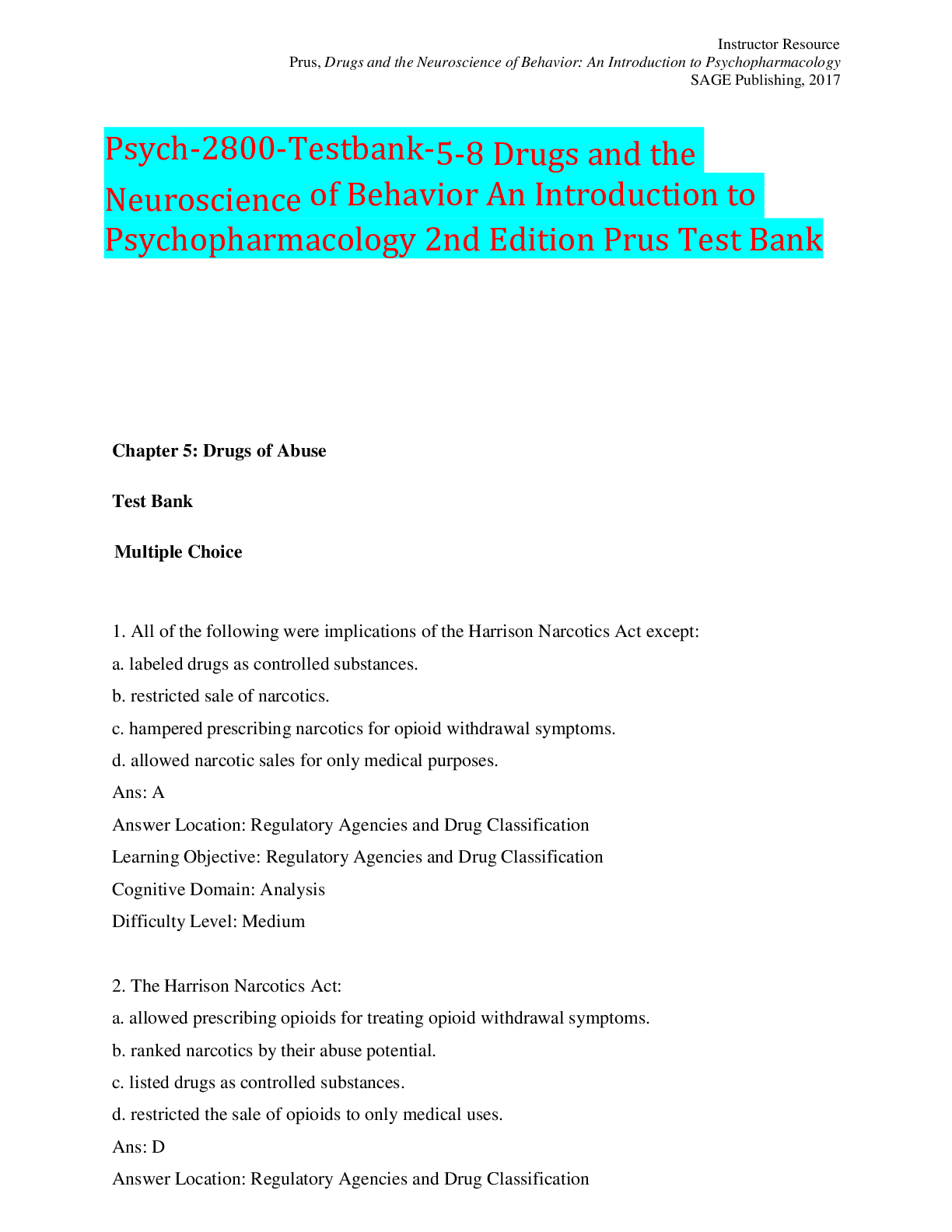
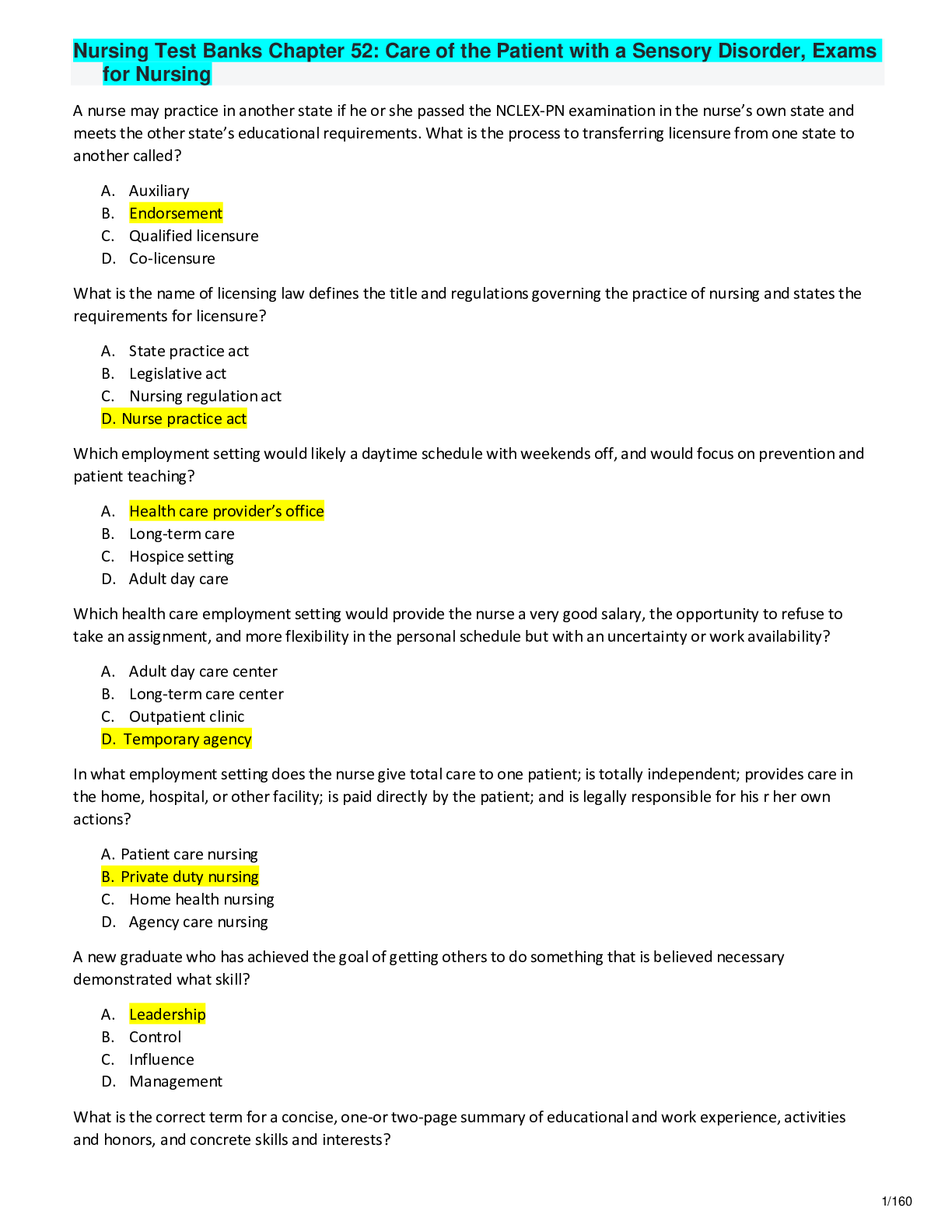

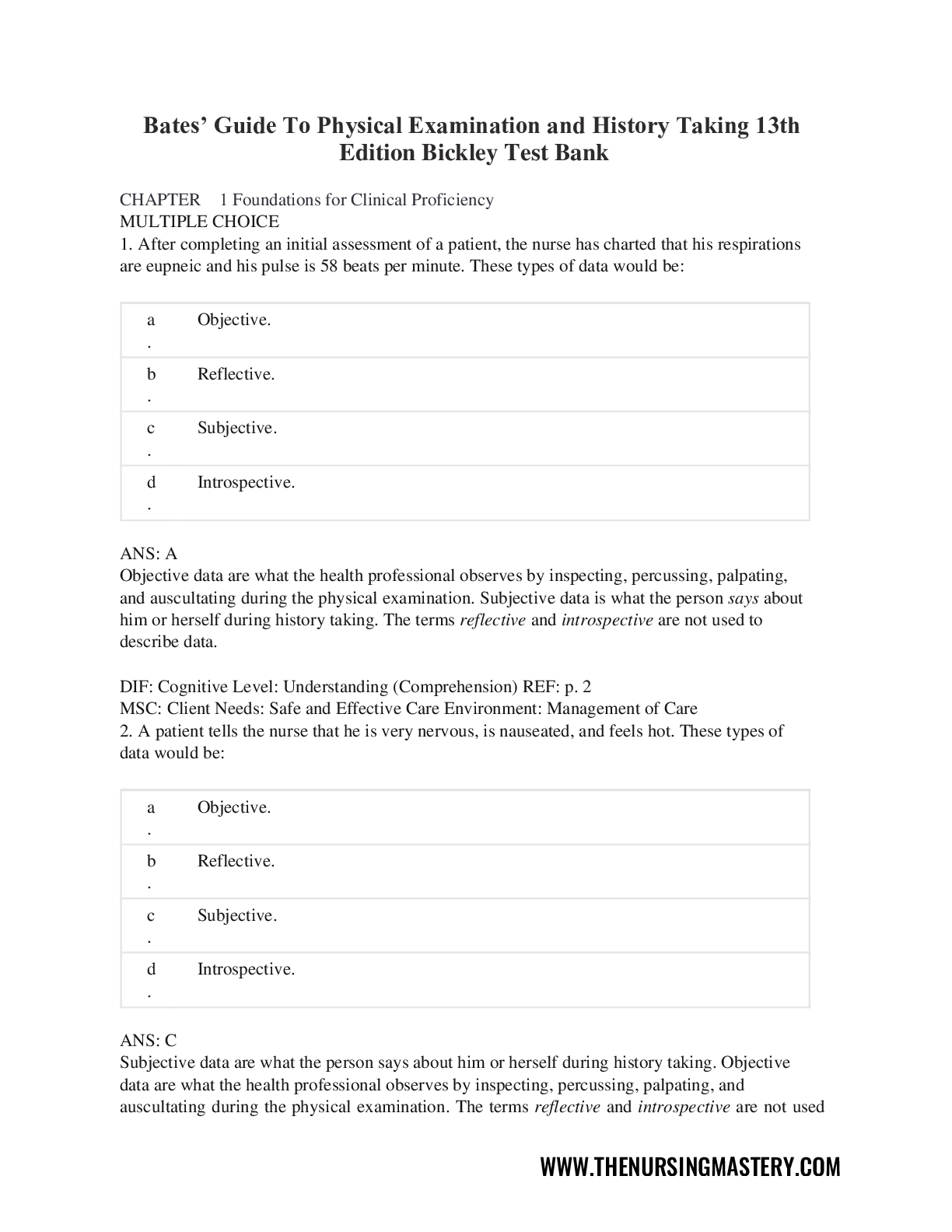
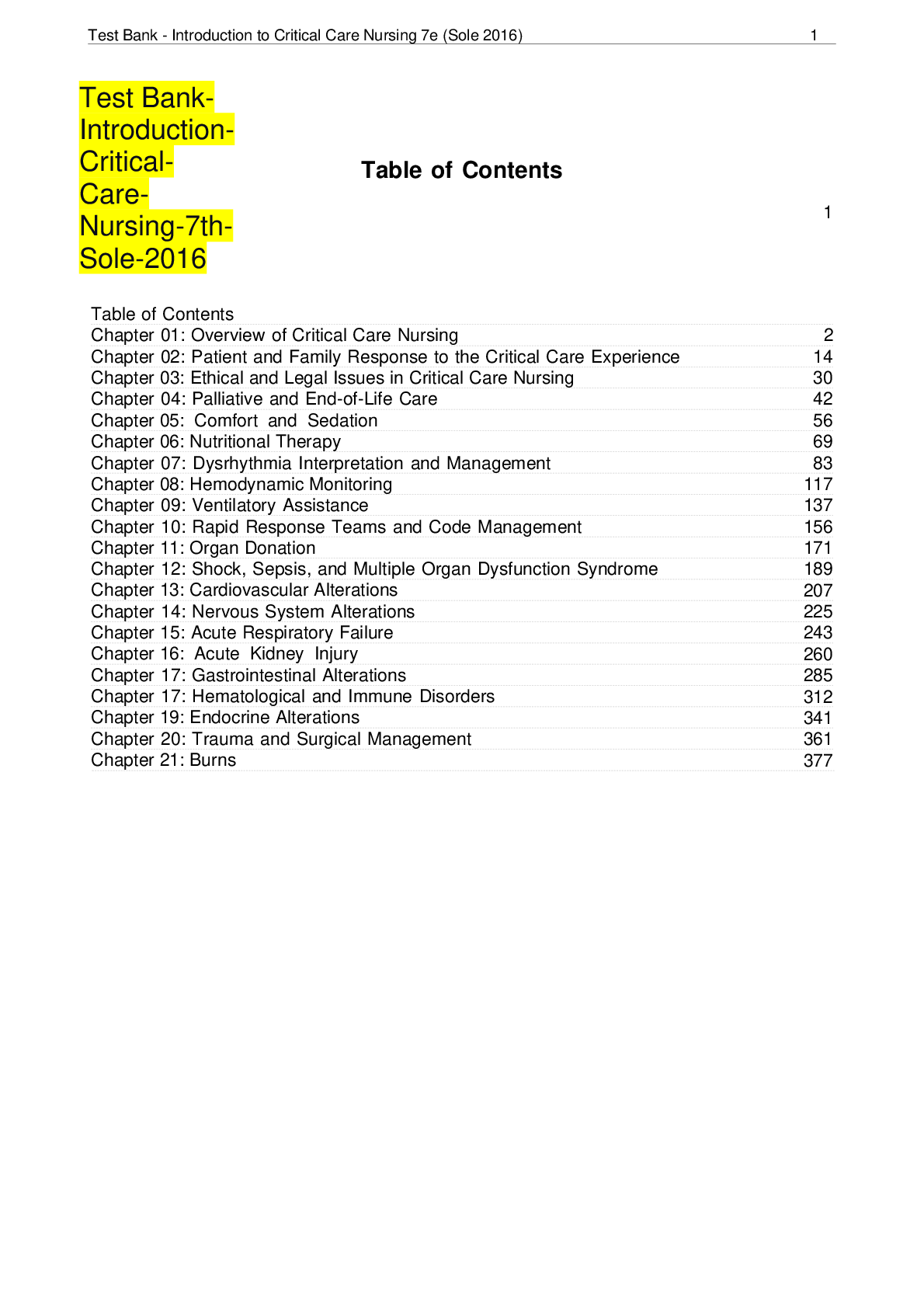
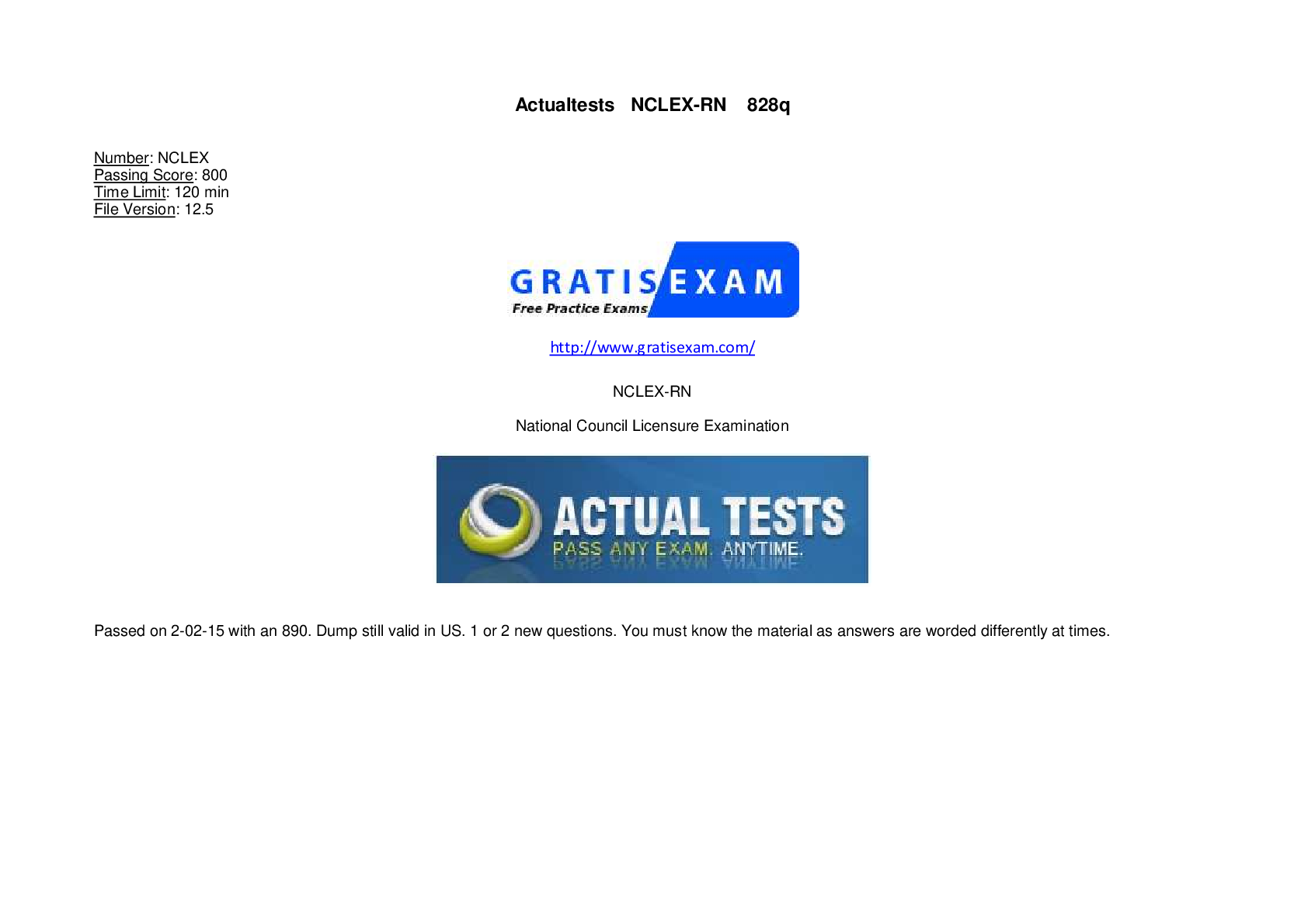



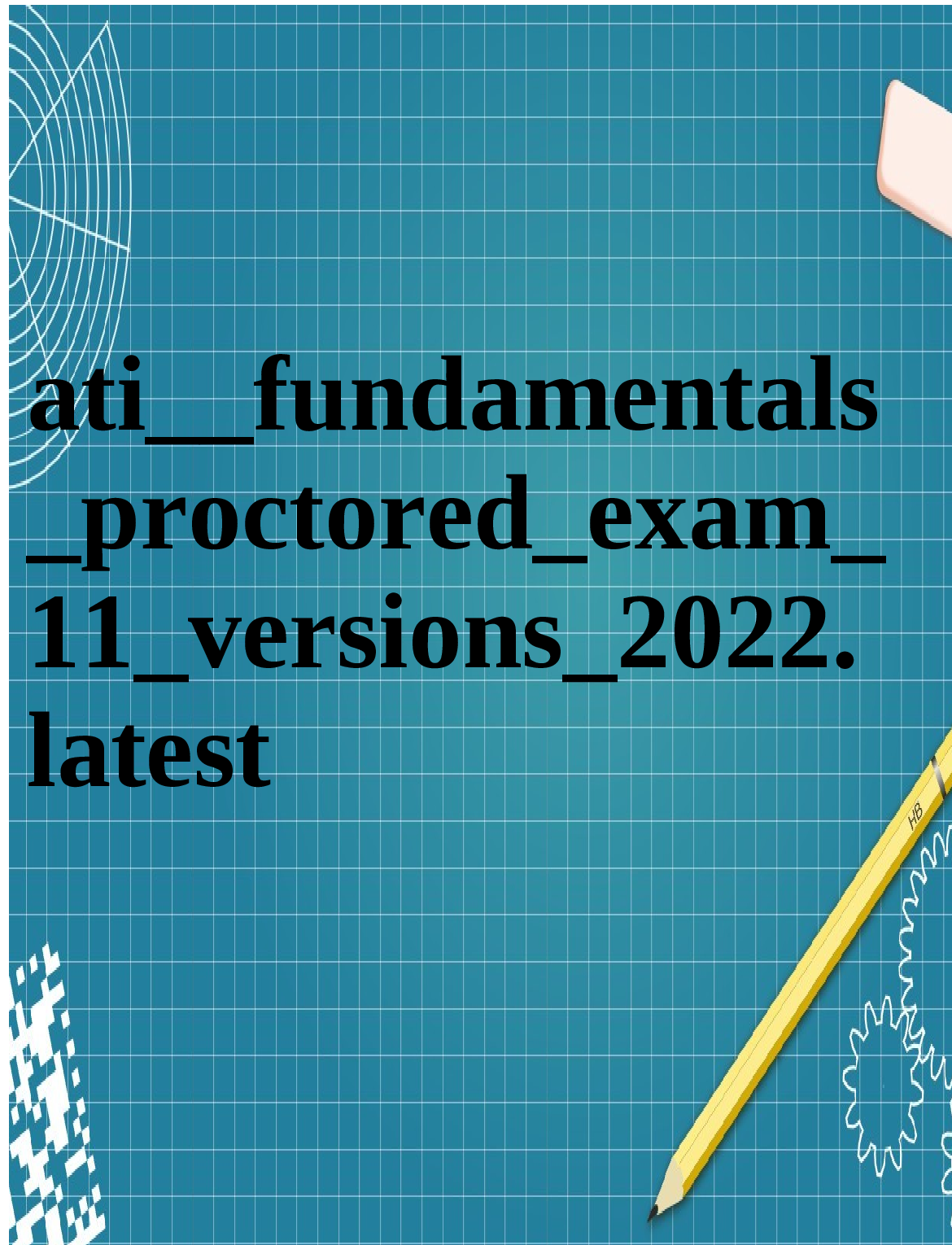
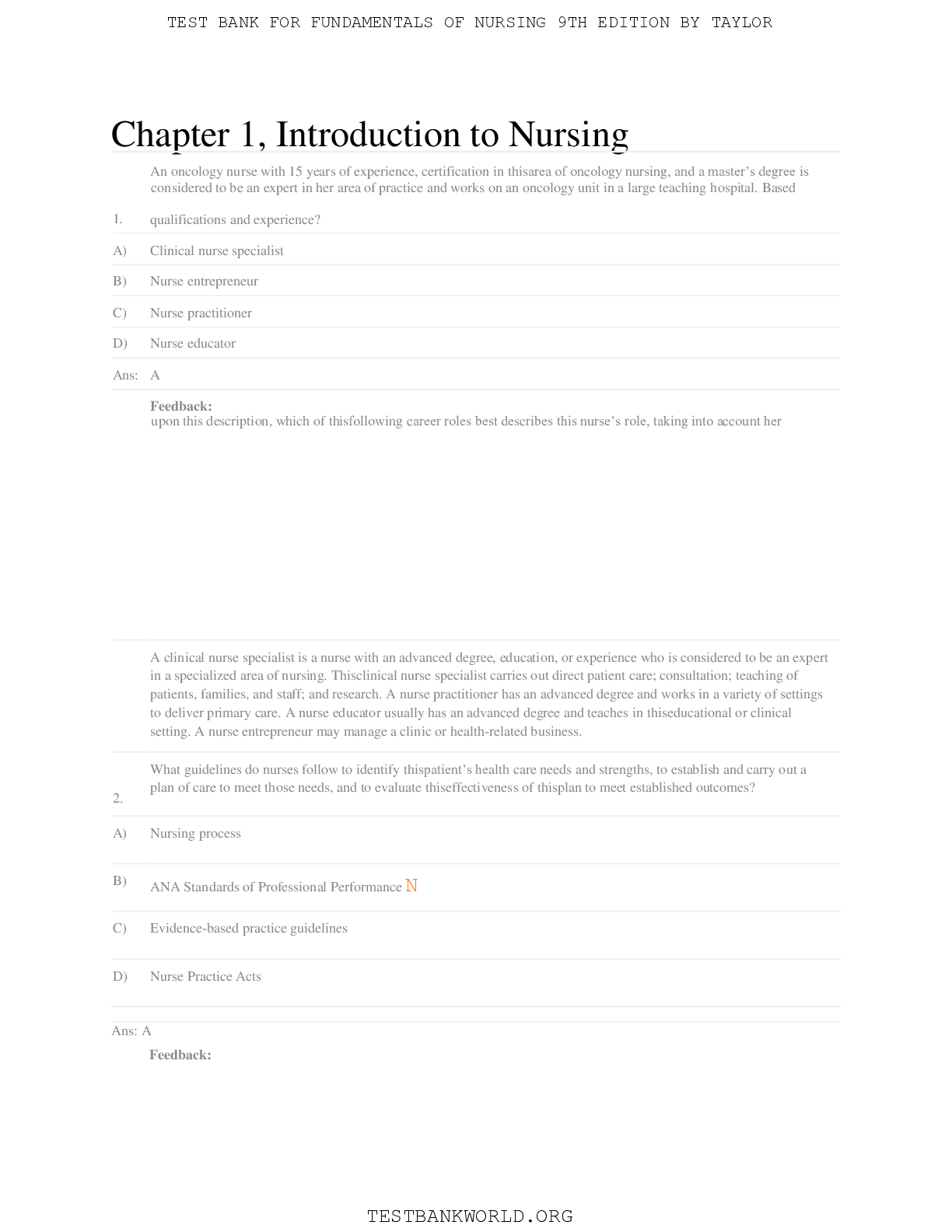
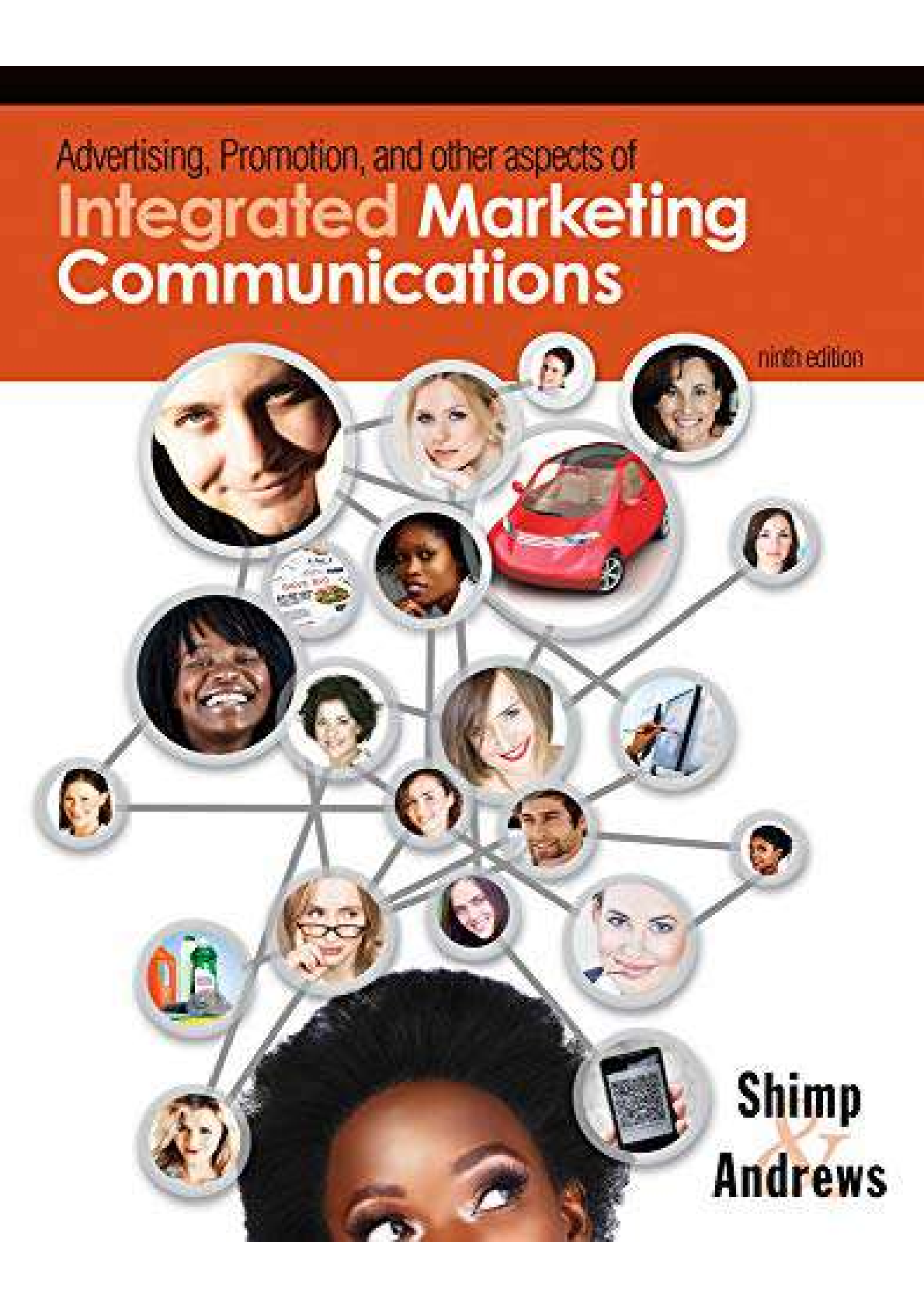
.png)
.png)
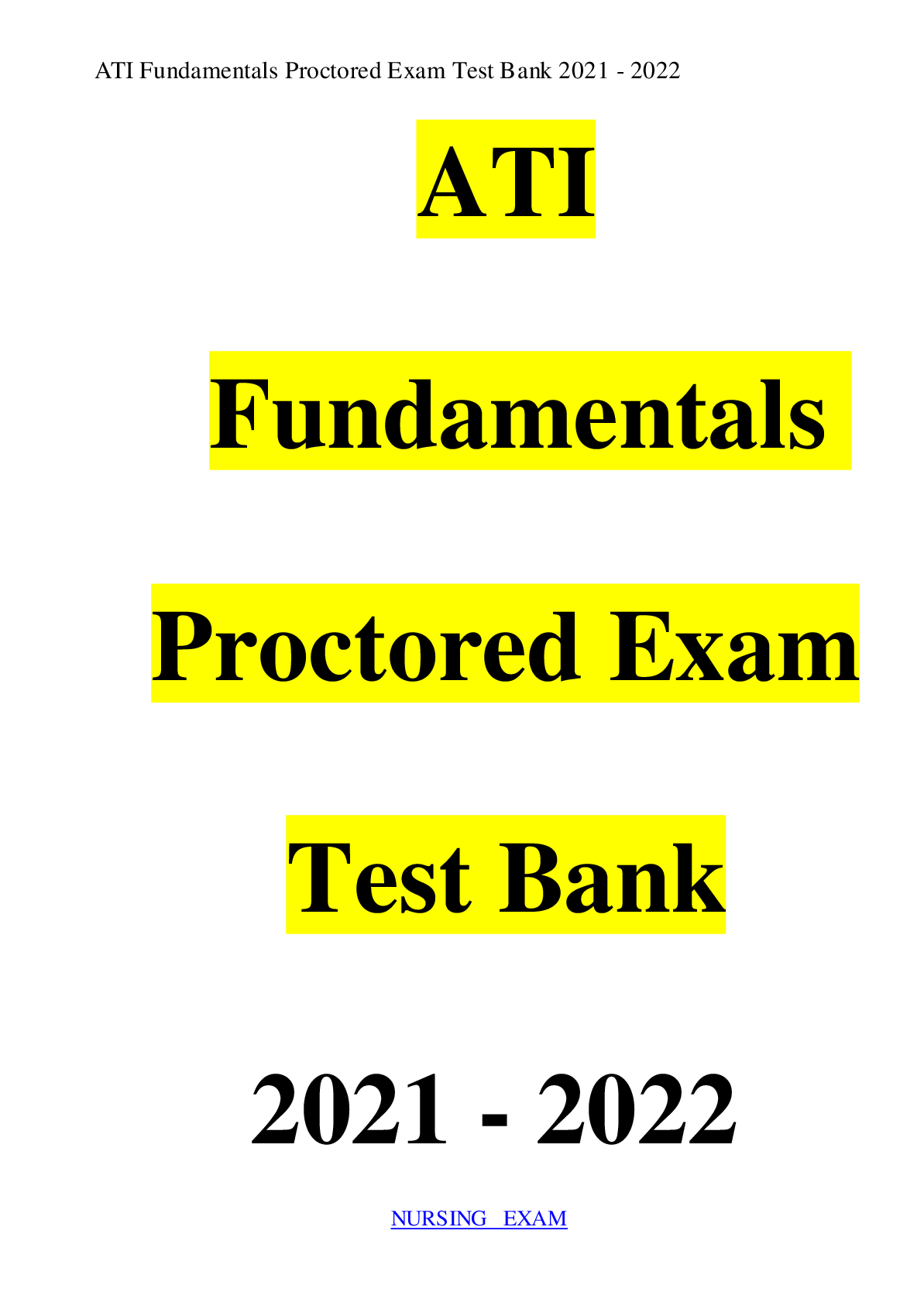
.png)
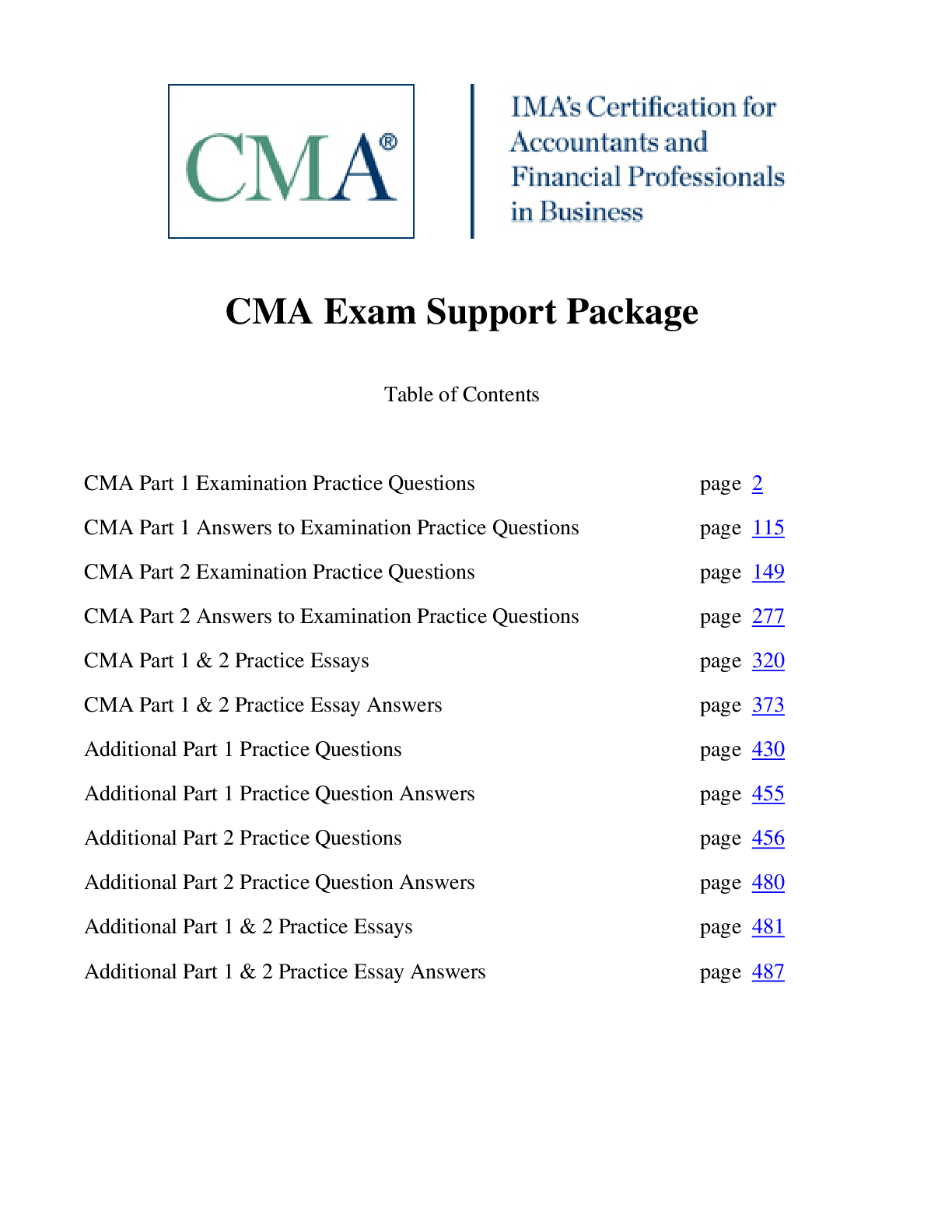








.png)
